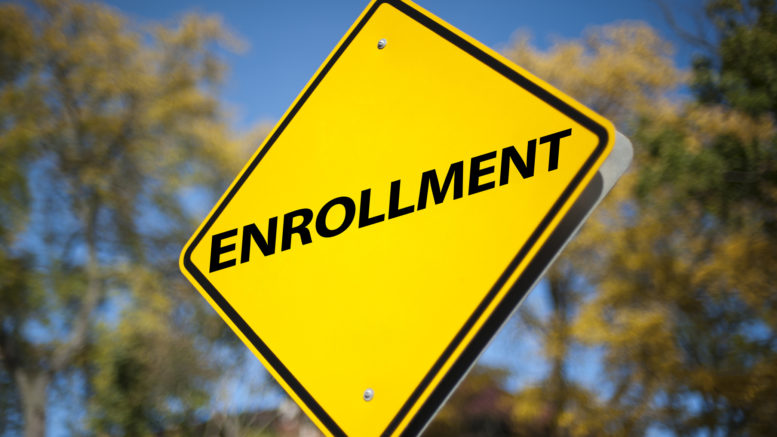Sharp drops in fall enrollments among Native American, Black and Hispanic community college freshmen are near 30%, according to updated data from the National Student Clearinghouse (NSC) Research Center.
The decline in the overall freshman enrollment estimate this fall has been refined from last month’s report of -16% to a still substantial -13%, a new NSC Research Center report shows. Community colleges still show the sharpest drop among freshmen (-18.9%), almost 19 times the pre-pandemic loss rate, according to the center. Public four-year institutions declined -10.5% and private nonprofit four-year institutions dropped -8.5%.
Freshman enrollment is seeing significant drops among nearly all races and ethnicities across higher education sectors. An interactive dashboard feature in the research center’s latest report shows that community colleges are seeing staggering drops among freshmen based on race/ethnicity, especially among Native Americans, Blacks and Hispanics (see chart, below).
“That’s a separation that we don’t see in the other sectors,” said Doug Shapiro, executive director of the NSC Research Center.
Fall enrollment continues to slip
Fall enrollments for all undergraduates continue to drop based on more incoming data from colleges to NSC, with the steepest decrease remaining among community college students. Overall, undergraduate enrollment is down -4.4%, while graduate enrollment is up 2.9% compared to the same time last year, according to the latest data. The center’s previous report released last month showed a -4% decrease in undergraduate enrollment and a 2.7% growth in graduate enrollment.
Community colleges are seeing the biggest drop in the latest report at -9.5%. The report in October noted a drop at the time of -9.4%. Last fall, the enrollment decrease among community college was -1.2%, the research center said.
According to the new report, decreases in other higher education sectors include: -2.1% at private nonprofit four-year colleges; -1.9% at public four-year colleges; and -0.1% at private for-profit four-year colleges.
Based on enrollment by credential type, those typically awarded by community colleges also are seeing the biggest hits. Enrollments in undergraduate certificate and associate degree programs are down -9% this fall, compared to -4% and -1.8% in fall 2019, respectively. Baccalaureate enrollment this fall has dropped -1.1%, compared to -0.5% last fall. Meanwhile, fall enrollments are up for graduate credentials, including post-baccalaureate certificate, master’s degrees and doctorates.
Undergraduate enrollment at primarily online institutions, where more than 90% of students enrolled exclusively online before the pandemic, increased by 4.9%, primarily due to growth in the number of part-time students, the center said.
This third update to the center’s fall 2020 series is based on 13.6 million enrolled students from 76% of postsecondary institutions reporting to the Clearinghouse, as of October 22. The center will provide the final fall enrollment data on December 17.
Holding off?
Many higher education researchers had expected to see some increases in community college enrollments due to the pandemic, led primarily by adults who lost their jobs and headed to college to upgrade their skills or change careers. But that hasn’t happened. Shapiro speculated that many adults may have felt that the jolted economy would get back on track in a few months and opted to wait to find a new job rather than enroll in college. Historically, community college enrollments increase during recessions.
“This is still a big surprise,” said Shapiro, who added that stresses on family finances during the pandemic may also be keeping potential community college students from enrolling.
However, if the employment outlook doesn’t change significantly, and colleges continue to hold most of their classes remotely, community college enrollments could increase in the spring or next fall, he said.
Breakdown by states
The center also has added to its interactive dashboard information on states that is broken down by higher education sectors. Montana saw the largest decrease in community college enrollments (-17.8%), followed by Arizona (-17.5%), Tennessee (-15.4%), Connecticut (-15.3%) and Florida (-14.7%). There were no obvious regional declines based on the data.
Meanwhile, South Dakota and Idaho have continued to see increases. South Dakota saw an increase of 6.8% this fall compared to 3.3% last fall. Idaho saw an increase of 3.7% compared to 2.4% last fall.
The report also shows:
- A greater decrease among full-time community college students (-9.6%) than part-time students (-9.3%).
- A larger enrollment decrease among community colleges in cities and towns (a -10% drop in both) compared to rural areas (-9.1%) and suburban areas (-8.5%).
- At community colleges, male students decreased considerably more than females (-14.4% compared to -6%) and among all racial and ethnic groups.
- Community college enrollments among students age 17 and younger – typically dual-enrollment students – saw a decrease this fall of -4.2%, compared to fall 2019, when their enrollments were up 10 percent. It was the only age group last fall that saw enrollment increases at community colleges.
A growing number of community colleges across the country have in recent years relied more on dually enrolled high school students to help at least stabilize their overall enrollment. So it was a bit surprising to see those numbers drop, too.
Education advocates have speculated that uncertainties about how their own high schools would operate this fall prompted high school students to wait and see about dual enrollment. Some advocates even hoped that once the fall situation settled that perhaps students would enroll in those courses later in the term.
“That’s certainly not panning out in this report. The dual-enrolled students are even worse now than they were a month ago,” Shapiro said.

